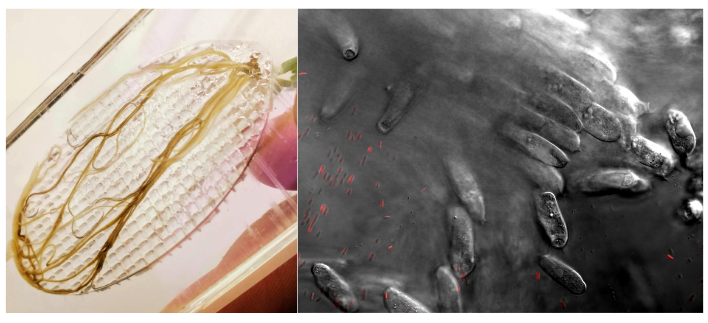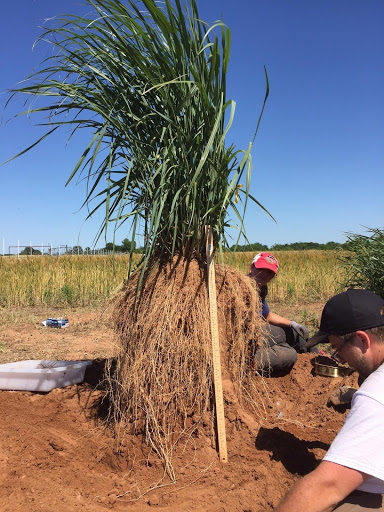Rhizobiome succession

Imagine that we discover a miracle microbe that dramatically improves plant growth. How do we introduce it into a complex soil ecosystem so that it persists? Will the addition of one microbe be able to change a microecosystem? What are the characteristics of persistent and impactful microbes in the rhizosphere? Understanding rhizobiome succession will allow us to deploy microbial soil amendments that have large-scale impacts on bioenergy crops like switchgrass.
Using our switchgrass isolate collection, we probe increasingly complex communities and measure our impact with microscopy, metabolomics, and metagenomic techniques. We have developed imaging EcoFABs (left) to allow us to image plant and colonizing bacteria, shown emitting red fluorescence (right).
Researching rhizobiome succession will increase our understanding of soil microbial community dynamics and improve deployment of agricultural probiotics for increased crop yields.
Switchgrass-microbe interactions

Switchgrass is one of the most promising bioenergy crops in the U.S. Sustainable cultivation of switchgrass is enabled by soil-plant-microbial interactions. Yet understanding of the occurrence and regulation of mutualistic switchgrass-microbe interactions, carbon and nutrient exchange between roots, soil food webs, rhizosphere carbon, nitrogen, phosphorus is limited.
To uncover switchgrass-microbe interactions we use single plant-microbe pairing and ‘community’ systems biology approaches, including exometabolomics of switchgrass-microbe interactions, comparative genomics of switchgrass isolates and synthetic communities, probing the microbial activity in the rhizosphere with stable isotopes and BONCAT.
Deep understanding of the switchgrass microbiome will enable more efficient manipulation of the microbial communities for beneficial purposes. It will also provide nature-inspired solutions for sustainable agriculture, increased crop yields and improved soil fertility.

Recent findings:
- Created large collection of switchgrass isolates, analyzed their abundances in marginal fields
- Identified signature metabolites in exudate profiles of switchgrass during nutrient stresses
- Found how dynamic root exudate chemistry and microbial substrate preferences drive patterns in rhizosphere microbial community assembly (Zhalnina et al., 2018)
